Markets Drop in Last Session of 2005
Wall Street couldn’t muster a rally on the last trading day of the year, leaving major market indexes at their December lows.
The Dow Jones industrials finished the year slightly in the red, but nearly all other indexes posted gains for 2005.
In other trading, Treasury bond yields edged up, and oil and gold also rose.
The Dow fell 67.32 points, or 0.6%, to 10,717.50. It also was down 0.6% for the year, the first annual decline since 2002, which was the final year of the last bear market.
Broader stock indicators also lost ground Friday. The Standard & Poor’s 500 fell 6.13 points, or 0.5%, to 1,248.29 but was up 3% for the year.
The technology-dominated Nasdaq composite fell 12.84 points, or 0.6%, to 2,205.32. For the year, it rose 1.4%.
Still, it wasn’t as tough to make decent money in stocks as the well-known indexes might imply. The market’s stars were small and mid-size stocks, energy-related shares and foreign issues.
Within the S&P; 500, 67 stock sectors posted gains for the year while 47 declined.
The best-performing sector: oil and gas refiners, up 77.3% for the year, on average.
The worst performer: auto stocks, down 49.2%.
Stocks had surged in November, but nervousness about the economy overtook the market in December. The much-anticipated “Santa Claus” rally never really materialized as concerns once again arose over the Federal Reserve’s policies and as energy prices marched back above $60 a barrel.
Near-term crude futures ended the year at $61.04 a barrel, up 72 cents for the day.
Although the Fed signaled in mid-December that it may be nearing the end of its credit-tightening campaign, some investors are fearful that the central bank already has raised rates enough to sharply slow the economy.
“Essentially the [bond] market’s saying that the Fed’s going to go too far,” said Mitchell Stapley, who oversees $14 billion as chief fixed income officer at Fifth Third Bank in Grand Rapids, Mich.
In the Treasury bond market this week, long-term yields fell below shorter-term yields. Historically, that often has been a sign that bond investors expected the economy to slow significantly, pulling all interest rates down.
The 10-year T-note yield ended the year at 4.39%, up from 4.36% on Thursday and 4.22% a year ago.
The two-year T-note ended at 4.40%, up from 4.37% on Thursday and 3.07% a year ago.
The powerful rally in gold in recent months also has raised red flags on Wall Street because investors often turn to gold when they expect economic or market turmoil ahead.
Near-term gold futures in New York ended Friday at $517.10 an ounce, up $1.40 for the day. The metal soared $48 for the quarter and nearly $80, or 18%, for the year.
Stock market optimists note that equities were roaring just a few weeks ago and aren’t much below those highs. The S&P; 500 hit a 4 1/2 -year high Dec. 14 and has lost a modest 1.9% from that level.
The S&P; small-stock index hit a record high Dec. 14 and is down 3% since then.
Among Friday’s highlights:
* Energy stocks capped their big gains for the year with a modest rally. Halliburton rose 52 cents to $61.96, Amerada Hess was up $1.13 to $126.82 and Anadarko Petroleum added $1.10 to $94.75. Valero Energy, the best performing stock in the S&P; 500 this year, was unchanged at $51.60 after gaining 127% on the year.
* Google fell $5.29 to $414.86 after Rates Technology Inc. said it filed suit claiming Google inappropriately used its voice over Internet technology in its Google Talk product, introduced this year. Google said the suit was without merit.
The Internet search giant’s shares were one of the year’s biggest winners, up 115%.
* Chip maker Intel fell 11 cents to $24.96 as it plans to unveil a new branding strategy that includes a new logo, a change in its “Intel Inside” stickers on personal computers and the termination of the long-standing Pentium brand name. Intel was up 6.7% for the year.
* Hewlett-Packard eased 11 cents to $28.63 but was the year’s biggest gainer in the 30-stock Dow index, rallying 36.5%. The second-biggest gainer was Boeing, up 35.7% after losing 94 cents to $70.24 on Friday.
General Motors was the Dow’s biggest loser, falling 51.5% for the year despite a gain of 41 cents to $19.42 on Friday.
More to Read
Inside the business of entertainment
The Wide Shot brings you news, analysis and insights on everything from streaming wars to production — and what it all means for the future.
You may occasionally receive promotional content from the Los Angeles Times.










